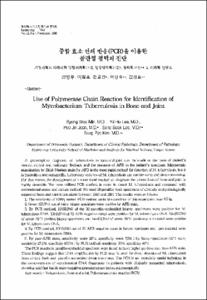중합 효소 연쇄 반응(PCR)을 이용한 골관절 결핵의 진단
- Keimyung Author(s)
- Min, Byung Woo; Chun, Hyo Jin; Lee, Sang Sook; Kim, Sang Pyo
- Department
- Dept. of Orthopedic Surgery (정형외과학)
Dept. of Laboratory Medicine (진단검사의학)
Dept. of Pathology (병리학)
Institute for Medical Science (의과학 연구소)
- Journal Title
- Keimyung Medical Journal
- Issued Date
- 1996
- Volume
- 15
- Issue
- 4
- Abstract
- A presumptive diagnosis of tuberculosis in bone and joint can be made on the basis of patient's history, clinical and radiologic findings, and the presence of AFB in the patient's specimen. Microscopic examination by Ziehl-Neelsen stain for AFB is the most rapid method for detection of M. tuberculosis, but it is insensitive and nonspecific. Laboratory cultures of M. tuberculosis are cumbersome and time consuming. For that reason, the development of a more rapid method to diagnose the tuberculosis of bone and joint is highly desirable. We have utilized PCR method in order to detect M. tuberculosis and compared with conventional smear and culture method. We used 30 paraffin block specimens of clinically and pathologically suspected bone and joint tuberculosis between 1992 and 1994. The results were as follows:
1. The sensitivity of IS986, nested-PCR method under the condition of this experiment was 0.5fg.
2. Seven(23.3%) out of thirty biopsy specimen were positive by AFB stain.
3. By PCR method, 19(63.3%) of the 30 paraffin-embedded biopsy specimens were positive for M. tuberculosis DNA. 10(43.5%) of 23 AFB-negative cases were positive for M. tuberculosis DNA. Six(85.7%) fo seven AFB-positive biopsy specimens and four(57.1%) of seven AFB-positive pus material were positive for M. tuberculosis DNA.
4. By PCR method, 10(58.8%) out of 17AFB negative cases in biopsy specimen and pus material were positive for M. tuberculosis DNA.
5. By pus-AFB stain, sensitivity were 20%, specificity were 70% ; by biosy-specimen-AFB stain, sensitivity 27.2%, specificity 87.5%;by PCR method, sensitivity 70%, specificity 41%.
The PCR results in paraffin-embedded specimen were found to have higher positive rate than AFB stain. These findings suggest that DNA amplification by PCR may be used for direct detection of M. tuberculosis from clinical fresh and paraffin embedded tissue specimens. The PCR is an especially useful technique in the demonstration of mycobaterial DNA fragments in patients with clinically suspected tuberculosis, showing acid fast bacilli stain-negative granulomatous lesion, microscopically.
- Alternative Title
- Use of Polymerase
Chain Reaction for Identification of Mycobacterium Tuberculosis in Bone and Joint
- Publisher
- Keimyung University School of Medicine
- Citation
- 민병우 et al. (1996). 중합 효소 연쇄 반응(PCR)을 이용한 골관절 결핵의 진단. Keimyung Medical Journal, 15(4), 327–333.
- Type
- Article
- Appears in Collections:
- 2. Keimyung Medical Journal (계명의대 학술지) > 1996
1. School of Medicine (의과대학) > Dept. of Laboratory Medicine (진단검사의학)
1. School of Medicine (의과대학) > Dept. of Orthopedic Surgery (정형외과학)
1. School of Medicine (의과대학) > Dept. of Pathology (병리학)
3. Research Institutues (연구소) > Institute for Medical Science (의과학연구소)
- 파일 목록
-
-
Download
 15-327.pdf
기타 데이터 / 425.89 kB / Adobe PDF
15-327.pdf
기타 데이터 / 425.89 kB / Adobe PDF
-
Items in Repository are protected by copyright, with all rights reserved, unless otherwise indicated.